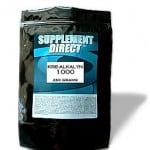Creatine is made up of the amino acids arginine, glycine, and L-methionine, which are synthesized in the liver and kidneys. Some creatine is obtained naturally from meat and fish in the diet, particularly those containing high levels such as beef, tuna, and herring though some are destroyed when meat is cooked. An average human has approximately 120 grams of creatine in the body at any one time and this is broken down into creatinine at the rate of 2 grams a day and excreted by the kidneys.
At the most, athletes usually use doses of 3-5 grams of creatine supplements a day. This seems to be the most effective, maintainable regimen.
Functions of Creatine
Creatine is stored in the muscles of the body and is used to produce energy for muscle contraction. During exercise the muscle contraction and relaxation require energy. This is obtained when adenosine triphosphate (ATP) is broken down into adenosine diphosphate (ADP) in a process called dephosphorylation. The free energy that is released can then be used by the muscles.
The phosphastes in creatine are then used to rebuild ATP from ADP, so theoretically the more creatine in your muscles, the quicker ATP can be restored, resulting in more energy available in the muscles. Creatine is used for both strength gains and muscle gains and is often associated with increased stamina over a short period of time.
History of Creatine
In 1832 a French scientist identified a substance he called kreas (Greek for flesh.) A German scientist, Justus von Liebig, later helped promote a meat extract to give the body added strength, the key ingredient being creatine.
The use of creatine was the subject of an investigation following the 1992 Olympics where it was claimed that it was used as a supplement by some of the athletes. Bodybuilding supplements that contain creatine have been available since the 1920s to build muscle bulk.
Bodybuilding Supplements
Athletes and bodybuilders use creatine as a dietary supplement when they are trying to bulk up and gain body mass. It can be taken either in tablet form or as a powder. There are many different formulations such as creatine monohydrate, creatine citrate, creatine ester ethyl hydrochloride, and creatine ester ethyl, amongst others.
When deciding which product is most suitable, consult the consumer reviews. You will find reviews on creatine products are published at Consumer Lab. There have been reports of contaminated creatine supplements. Be sure to buy products made by established companies with good reputations.
Typically, users tend to choose powdered creatine such as creatine monohydrate, although recently creatine users are reporting excellent results from a product called Kre-Alkalyn. There are very few reports, if any, that promote the use of liquid creatine, effervescence, or any other form of creatine aside from monohydrate and Kre-Alkalyn.
Creatine Monohydrate
Creatine monohydrate is a tried and true creatine supplement that has withstood the athletes’ test of time. It works, it works best, and it will work for you. We recommended using front loading with creatine monohydrate, as mentioned below under Loading Doses.
Creatine Kre-Alkalyn
 Kre-Alkalyn has a higher absorption so it doesn’t require front loading and reportedly causes less creatine bloating and stomach problems. Kre-Alkalyn offers you a creatine supplement that is 100% stable, will not break down into creatinine, and will absorb efficiently into the bloodstream.
Kre-Alkalyn has a higher absorption so it doesn’t require front loading and reportedly causes less creatine bloating and stomach problems. Kre-Alkalyn offers you a creatine supplement that is 100% stable, will not break down into creatinine, and will absorb efficiently into the bloodstream.
Each gram of Kre-Alkalyn is equivalent to 10 grams of creatine powder.
Click here to order a bottle of Kre-Alkalyn.
How to Take Creatine
Creatine uptake into the muscle has been reported to be sodium-dependent and mediated by insulin. The general recommendation is that creatine is best taken with carbohydrates or simple sugars such as fruit juices to maximize its benefit. Taking creatine with 80-100 grams of glucose, or a carbohydrate/protein mix of 50-80 grams of carbs and 30-50 grams of protein, maybe the most effective way to enhance creatine uptake.
Creatine is usually taken in 8-10 week cycles with an initial loading phase of 5 days, and dropping down to the lower maintenance dose for the rest of the cycle. However, there is no evidence to suggest that cycling on and off creatine is more effective than loading and maintaining creatine use. The greatest reported benefit of creatine supplementation occurs with highly intense training. Therefore, if an athlete wants to cycle creatine, it will be more effective when they are involved in their heaviest training period.
As reported by Men’s Health, there is evidence that ingesting creatine with D-pinitol may also help creatine uptake to muscle.
If discomfort, diarrhea, or any other physical condition occurs whilst taking creatine, consult a physician immediately. Always read the label on the product of your choice and follow the guidelines.
Loading Doses
During the loading period, 20 grams of creatine protein powder is taken daily and this amount is broken down into several smaller doses that are taken at regular intervals throughout the day. Users typically take 5 grams, 4 times a day, for 5-7 days when front loading. Studies have shown very little benefit to exercise performance when front loading is not used, even when the athlete supplements with creating for a prolonged period of time.
After the loading period, only one dose of 3-5 grams is taken daily. The maintenance dose is often taken two to three hours before working out.
A newer form of creatine, called Kre-Alkalyn, discussed above, does not require any front loading. Currently, Kre-Alkalyn is growing more popular, however, it will take several more years of athletic supplementation to determine whether Kre-Alkalyn will be considered an equivalent or superior supplement to creatine monohydrate.
Contraindications
Although creatine is not generally considered a dangerous supplement, because of the potential for side effects and interactions with medications, dietary supplements should be taken only under the supervision of a knowledgeable health care provider. It is not advised to begin supplementing with creatine until you have first consulted with your doctor.
- Creatine is not recommended for individuals under 18 years of age.
- Consult a doctor before taking the product if you have an existing gastrointestinal or renal condition.
- Creatine is not recommended for women when they are pregnant or breastfeeding.
- People with kidney disease, high blood pressure, or liver disease should avoid creatine.
There are no studies that indicated specifically that creatine supplementation may be harmful to children or adolescent athletes. Long-term creatine supplementation has been used as therapy for a number of deficiencies and neuromuscular disorders in children. It should be noted that much less is known about the effects of creatine supplementation in younger individuals.
Although there are situations where adolescents would benefit from using creatine, such usage should be cleared and monitored by a physician. Creatine clearly is a much safer alternative to using steroids, especially for a teenager or young adult.
Advantages of Taking Creatine
Bodybuilding supplements such as creatine add fat-free mass to the body. When using creatine, fat-free mass gains are achieved through increased hydration within the muscle tissue and increased energy via the ATP-ADP cycle. Maintaining the body’s store of creatine allows the body to maintain higher energy levels and longer workouts.
The “PUMPS” are also significantly better, as the intra-muscular fluids are much greater than normal within the muscle(s) currently being trained. Using creatine definitely makes one appear much more Swole, at least during exercise. =)
Creatine users have reported the following benefits:
- Increased strength
- Increased energy
- Increased speed
- Increased power
- Increased stamina
- Increased muscle size
- Faster recovery times
- Less DOMs (soreness)
Creatine does not appear to cause many of the negative side effects normally associated with steroids such as aggression, higher blood pressure and pulse rate, and acne. Creatine also costs way less than most illegal sports supplements like steroids, insulin, and growth hormone.
Disadvantages Associated with Taking Creatine
Most studies have found no significant side effects at normal doses used for up to six months. In fact, there are currently no recorded adverse medical side effects other than water retention while taking creatine, and a reduction in energy levels and muscle turgidity and size, when the creatine supplementation is stopped.
However, some athletes have reported the following side effects when using creatine: weight gain, muscle cramps, muscle strains and pulls, stomach upset, diarrhea, dizziness, high blood pressure, liver dysfunction, and kidney damage. These side effects are most often reported when creatine usage is higher than the recommended daily intake, when fluid consumption is low, or when exercise conditions are extreme.
Taking creatine supplements may prevent the body from making its own natural stores, although the long-term effects are not known. The Food & Drug Administration recommends talking to your doctor before starting to take creatine.
Current Research
Research is currently underway on the potential benefits of creatine for patients with neuromuscular disorders, such as Parkinson’s, arthritis muscular dystrophy, and others, where it has been found to have an effect on muscular strength. Consult the common medical journals to read more about these studies.
Best Creatine Products
There are only two creatine products that I can recommend today. Creatine monohydrate and Creatine kre-alkalyn. Based on what you’ve just read, it’s your choice as to which product you want to try first… and next.
Creatine Monohydrate
The best creatine product with proven customer satisfaction is creatine monohydrate. There are no questions asked about creatine monohydrate, it just works.
Click here to get yourself some creatine monohydrate.
Creatine Kre-Alkalyn
Want to try a potentially superior creatine product? Try a bottle of Kre-Alkalyn, which in theory does not need to be front-loaded and will cause less gastrointestinal stress, for those whose digestive systems do not process creatine monohydrate very well.
Click here to order a bottle of Kre-Alkalyn.
Resources:
Creatine Overview at UMM
Creatine and Creatinine Metabolism
Creatine Journal
The Facts About Creatine
Tags: creatine, creatine monohydrate, kre-alkalyn, Supplements













I started taking creatine about one year into my fitness process. I have been taking it ever since. The main reason I decided to start taking creatine was because of its advertised benefits of increasing strength.
The type of creatine I am talking about here is creatine monohydrate.
Naturally the stronger you are the more lean muscle mass you can put on in the long run.
I also wanted to just increase my overall strength on all the exercises I was performing.
Creatine helps you build muscle mass. I use this supplement whenever I hit the gym.
I have never used ceratine but I found this post and learned something. I never knew there was such great benefits to using ccreatine. Thanks for the info. why would creatine make you drink more water?
Another good informtive article. Creatine is probably the most researched supplement that has been proven time and time again to be effective without harsh side effects. I stick with the monohydrate as most of the research has been conducted with monohydrate and it is the most cost effective. I find that I carry a bit of water weight but it doesn’t worry me. I do however find that the loading phase causes me to have an upset stomach. Now research into monohyddrate is suggesting that the loading phase isn’t necessary. What are your thoughts Steve?
Seems like the loading phase isn’t necessary. I just know that if I use creatine I have to drink more water than usual.
i took creatine monohydrate and experienced some sharp pains righh in my left side of lower chest what could have caused that, cause i had to stop taking it
It could be cramping. I’ve heard that creatine dries out some peoples’ ligaments and tendons, which can lead to sharp pains and sometimes injury. I’d consider not using creatine anymore, or if you have the time, patience, and money, then you can take it up with your doctor.
I have been taking Muscletech Celltech creatine for about 4 months now, cycling off halfway through. On the box it says to have a serving in the morning and a serving right after a workout for the loading stage and then a serving right after a workout in the maintaining phase. This contradicts what I read here. I love your stuff Steve and I just want to know which method to follow for the best results!
Just follow the instructions on the box. But why are you using anything from Muscletech?
I have buddies that have used Celltech and gotten great results. I have made leaps and bounds by using Celltech, Gakic and Leukic so the Muscletech brand seems to work pretty well for me. What do you suggest? And what is your distaste for Muscletech haha
I can’t stand their ads in the muscle mags, with monstrous pro bodybuilders offseason and contest pics side by side to sell fat burners. Ethically it’s disgusting, but I suppose we are all guilty of trying to make a quick buck now and then. I always thought Muscletech products were over priced, and 10+ years ago I never heard a good review about any of their products… maybe things have changed. Back in the day I also used to be a huge fan of Biotest, whose archnemesis’ are EAS and Muscletech, so I suppose I’m still biased.
Good idea, I agree with you.creatin in fact can be obtained from natural materials, but there were not many and therefore need additional materials such as supplements. Success.
I didn’t know that creatine was being researched for Parkinson’s and MD…my thesis was about the pharmacological effects of drugs on muscular dystrophy. Can’t wait to see their findings!
I notice protein powders have creatine listed as one of their ingredients. So it is really necessary to have creatine as a separate supplement unless you trying to be hardcore?
If your protein powder has creatine in the ingredients, it is probably a very small dosage.
Well one has creatine rated at 2.5% of the volume. But isn’t already present in a lot of food such as meat therefore it’s not necessary as a supplement unless you know what doing and are doing enough exercise to justify the extra creatine?
You wouldn’t want to supplement with creatine unless you were involved with exercise that uses predominantly ATP for energy, which would be strength training in the 1-20 rep range, powerlifting, strongman training, sprinting, rowing. Endurance runners, for example, are athletes who should not use creatine. I’m actually up in the air on rowing too – I guess it would depend on the length of the race or session.
Creatine is one of the few supplements that is not only safe, but works effectively.
I use it for a few months at a time, then cycle it off.
Good post Steve 🙂
I see you now luv the ComLuv. Thanks for the feedback man. Do you just use monohydrate?
One of the better creatine posts Ive seen! I would add that there are people who have used creatine for many years without deleterious side effects.
I would also add that most of the research over the last several decades is on creatine monohydrate and not the other stuff that is on the market.
For most people taking just 3 grams a day (or 0.3 g per kilogram) is enough.
Very interesting post. I too use creatine and have experienced some pretty impressive gains. However, I have heard/read some conflicting information when it comes to the :loading: phase.
Some have said that you should take 5g 3 times a day for 4 weeks.
Some say to use 8g at breakfast and after a work out for 6 weeks.
Still others say to take 6g at breakfast and after a work out for 8 weeks.
Are there any advantages/disadvantages to any of these strategies?